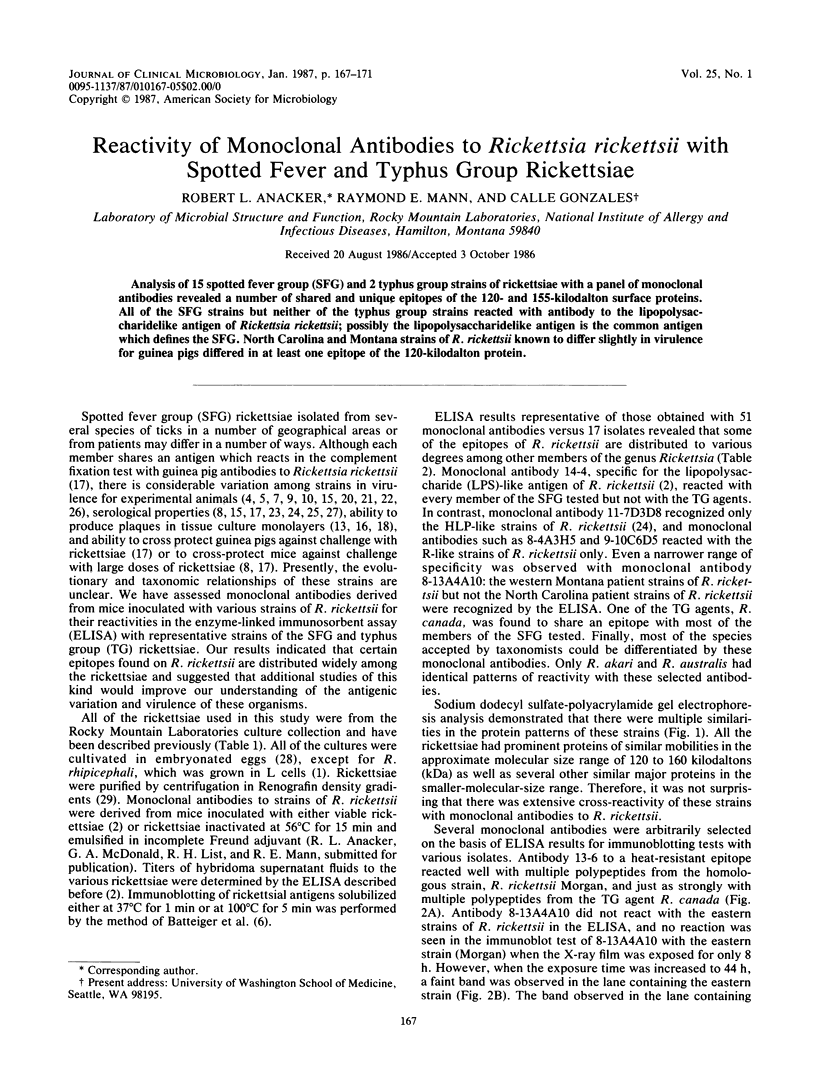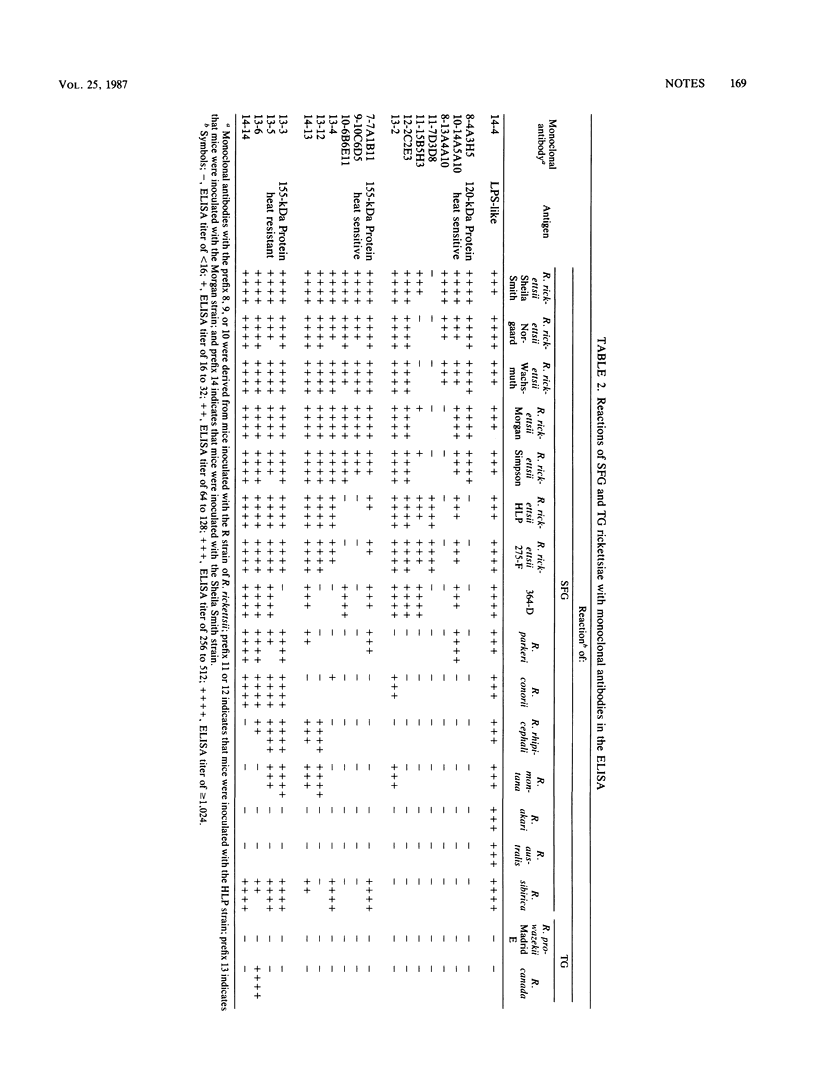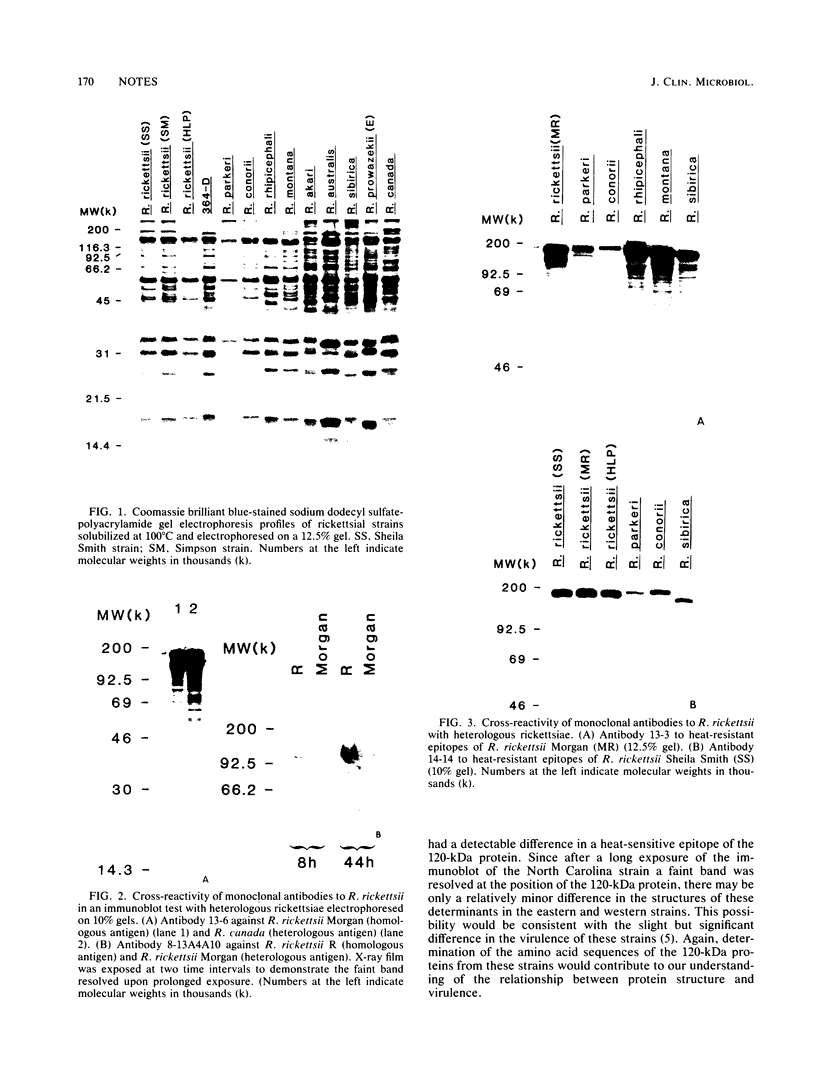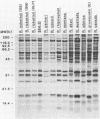Abstract
Analysis of 15 spotted fever group (SFG) and 2 typhus group strains of rickettsiae with a panel of monoclonal antibodies revealed a number of shared and unique epitopes of the 120- and 155-kilodalton surface proteins. All of the SFG strains but neither of the typhus group strains reacted with antibody to the lipopolysaccharidelike antigen of Rickettsia rickettsii; possibly the lipopolysaccharidelike antigen is the common antigen which defines the SFG. North Carolina and Montana strains of R. rickettsii known to differ slightly in virulence for guinea pigs differed in at least one epitope of the 120-kilodalton protein.
Full text
PDF




Images in this article
Selected References
These references are in PubMed. This may not be the complete list of references from this article.
- Anacker R. L., Gerloff R. K., Thomas L. A., Mann R. E., Brown W. R., Bickel W. D. Purification of Rickettsia rickettsi by density-gradient zonal centrifugation. Can J Microbiol. 1974 Nov;20(11):1523–1527. doi: 10.1139/m74-238. [DOI] [PubMed] [Google Scholar]
- Anacker R. L., List R. H., Mann R. E., Hayes S. F., Thomas L. A. Characterization of monoclonal antibodies protecting mice against Rickettsia rickettsii. J Infect Dis. 1985 Jun;151(6):1052–1060. doi: 10.1093/infdis/151.6.1052. [DOI] [PubMed] [Google Scholar]
- Anacker R. L., List R. H., Mann R. E., Wiedbrauk D. L. Antigenic heterogeneity in high- and low-virulence strains of Rickettsia rickettsii revealed by monoclonal antibodies. Infect Immun. 1986 Feb;51(2):653–660. doi: 10.1128/iai.51.2.653-660.1986. [DOI] [PMC free article] [PubMed] [Google Scholar]
- Anacker R. L., McCaul T. F., Burgdorfer W., Gerloff R. K. Properties of selected rickettsiae of the spotted fever group. Infect Immun. 1980 Feb;27(2):468–474. doi: 10.1128/iai.27.2.468-474.1980. [DOI] [PMC free article] [PubMed] [Google Scholar]
- Anacker R. L., Philip R. N., Williams J. C., List R. H., Mann R. E. Biochemical and immunochemical analysis of Rickettsia rickettsii strains of various degrees of virulence. Infect Immun. 1984 Jun;44(3):559–564. doi: 10.1128/iai.44.3.559-564.1984. [DOI] [PMC free article] [PubMed] [Google Scholar]
- BELL E. J., KOHLS G. M., STOENNER H. G., LACKMAN D. B. NONPATHOGENIC RICKETTSIAS RELATED TO THE SPOTTED FEVER GROUP ISOLATED FROM TICKS, DERMACENTOR VARIABILIS AND DERMACENTOR ANDERSONI FROM EASTERN MONTANA. J Immunol. 1963 May;90:770–781. [PubMed] [Google Scholar]
- BELL E. J., STOENNER H. G. Immunologic relationships among the spotted fever group of rickettsias determined by toxin neutralization tests in mice with convalescent animal serums. J Immunol. 1960 Feb;84:171–182. [PubMed] [Google Scholar]
- Batteiger B., Newhall W. J., 5th, Jones R. B. The use of Tween 20 as a blocking agent in the immunological detection of proteins transferred to nitrocellulose membranes. J Immunol Methods. 1982 Dec 30;55(3):297–307. doi: 10.1016/0022-1759(82)90089-8. [DOI] [PubMed] [Google Scholar]
- Bozeman F. M., Shiral A., Humphries J. W., Fuller H. S. Ecology of Rocky Mountain spotted fever. II. Natural infection of wild mammals and birds in Virginia and Maryland. Am J Trop Med Hyg. 1967 Jan;16(1):48–59. [PubMed] [Google Scholar]
- Burgdorfer W., Sexton D. J., Gerloff R. K., Anacker R. L., Philip R. N., Thomas L. A. Rhipicephalus sanguineus: vector of a new spotted fever group rickettsia in the United States. Infect Immun. 1975 Jul;12(1):205–210. doi: 10.1128/iai.12.1.205-210.1975. [DOI] [PMC free article] [PubMed] [Google Scholar]
- Cory J., Yunker C. E., Ormsbee R. A., Peacock M., Meibos H., Tallent G. Plaque assay of rickettsiae in a mammalian cell line. Appl Microbiol. 1974 Jun;27(6):1157–1161. doi: 10.1128/am.27.6.1157-1161.1974. [DOI] [PMC free article] [PubMed] [Google Scholar]
- Hughes L. E., Clifford C. M., Gresbrink R., Thomas L. A., Keirans J. E. Isolation of a spotted fever group rickettsia from the Pacific Coast tick, Ixodes pacificus, in Oregon. Am J Trop Med Hyg. 1976 May;25(3):513–516. doi: 10.4269/ajtmh.1976.25.513. [DOI] [PubMed] [Google Scholar]
- Johnson J. W., Pedersen C. E., Jr Plaque formation by strains of spotted fever rickettsiae in monolayer cultures of various cell types. J Clin Microbiol. 1978 Apr;7(4):389–391. doi: 10.1128/jcm.7.4.389-391.1978. [DOI] [PMC free article] [PubMed] [Google Scholar]
- LACKMAN D. B., BELL E. J., STOENNER H. G., PICKENS E. G. THE ROCKY MOUNTAIN SPOTTED FEVER GROUP OF RICKETTSIAS. Health Lab Sci. 1965 Jul;2:135–141. [PubMed] [Google Scholar]
- McDade J. E., Stakebake J. R., Gerone P. J. Plaque assay system for several species of Rickettsia. J Bacteriol. 1969 Sep;99(3):910–912. doi: 10.1128/jb.99.3.910-912.1969. [DOI] [PMC free article] [PubMed] [Google Scholar]
- Ormsbee R., Peacock M., Philip R., Casper E., Plorde J., Gabre-Kidan T., Wright L. Antigenic relationships between the typhus and spotted fever groups of rickettsiae. Am J Epidemiol. 1978 Jul;108(1):53–59. [PubMed] [Google Scholar]
- PARKER R. R., PICKENS E. G., LACKMAN D. B., BELLE E. J., THRAIKILL F. B. Isolation and characterization of Rocky Mountain Spotted Fever Rickettsiae from the rabbit tick Haemaphysalis leporis-palustris Packard. Public Health Rep. 1951 Apr 13;66(15):455–463. [PMC free article] [PubMed] [Google Scholar]
- Philip R. N., Casper E. A., Burgdorfer W., Gerloff R. K., Hughes L. E., Bell E. J. Serologic typing of rickettsiae of the spotted fever group by microimmunofluorescence. J Immunol. 1978 Nov;121(5):1961–1968. [PubMed] [Google Scholar]
- Philip R. N., Casper E. A. Serotypes of spotted fever group rickettsiae isolated from Dermacentor andersoni (Stiles) ticks in western Montana. Am J Trop Med Hyg. 1981 Jan;30(1):230–238. doi: 10.4269/ajtmh.1981.30.230. [DOI] [PubMed] [Google Scholar]
- Philip R. N., Lane R. S., Casper E. A. Serotypes of tick-borne spotted fever group rickettsiae from western California. Am J Trop Med Hyg. 1981 May;30(3):722–727. doi: 10.4269/ajtmh.1981.30.722. [DOI] [PubMed] [Google Scholar]
- Public Health Weekly Reports for NOVEMBER 8, 1946. Public Health Rep. 1946 Nov 8;61(45):1605–1640. [PMC free article] [PubMed] [Google Scholar]
- Robertson R. G., Wisseman C. L., Jr Tick-borne rickettsiae of the spotted fever group in West Pakistan. II. Serological classification of isolates from West Pakistan and Thailand: evidence for two new species. Am J Epidemiol. 1973 Jan;97(1):55–64. doi: 10.1093/oxfordjournals.aje.a121485. [DOI] [PubMed] [Google Scholar]
- STOENNER H. G., LACKMAN D. B., BELL E. J. Factors affecting the growth of rickettsias of the spotted fever group in fertile hens' eggs. J Infect Dis. 1962 Mar-Apr;110:121–128. doi: 10.1093/infdis/110.2.121. [DOI] [PubMed] [Google Scholar]
- Weiss E., Coolbaugh J. C., Williams J. C. Separation of viable Rickettsia typhi from yolk sac and L cell host components by renografin density gradient centrifugation. Appl Microbiol. 1975 Sep;30(3):456–463. doi: 10.1128/am.30.3.456-463.1975. [DOI] [PMC free article] [PubMed] [Google Scholar]





